Management and Operations at Lidl: Leadership Theories and Practices
VerifiedAdded on 2021/10/14
|26
|6331
|386
Report
AI Summary
This report provides a comprehensive analysis of leadership and management practices within Lidl, a major food retailer. It begins by differentiating between leaders and managers, highlighting their distinct roles and approaches. The report then delves into various leadership theories, including trait theory and different leadership styles like autocratic, democratic, transformational, and transactional, examining their application within Lidl. It also explores managerial functions such as planning, organizing, directing, and controlling, illustrating their importance in achieving organizational goals. Furthermore, the report examines the role of leaders and managers in operations management, emphasizing decision-making, communication, and conflict resolution. It also discusses the impact of environmental factors on operations management and how Lidl aligns its practices to meet business objectives, drawing on examples of Lidl's practices and strategies. The report also includes a discussion on hard and soft leadership skills. Overall, the report offers insights into Lidl's operational strategies, leadership styles, and their impact on the company's success.
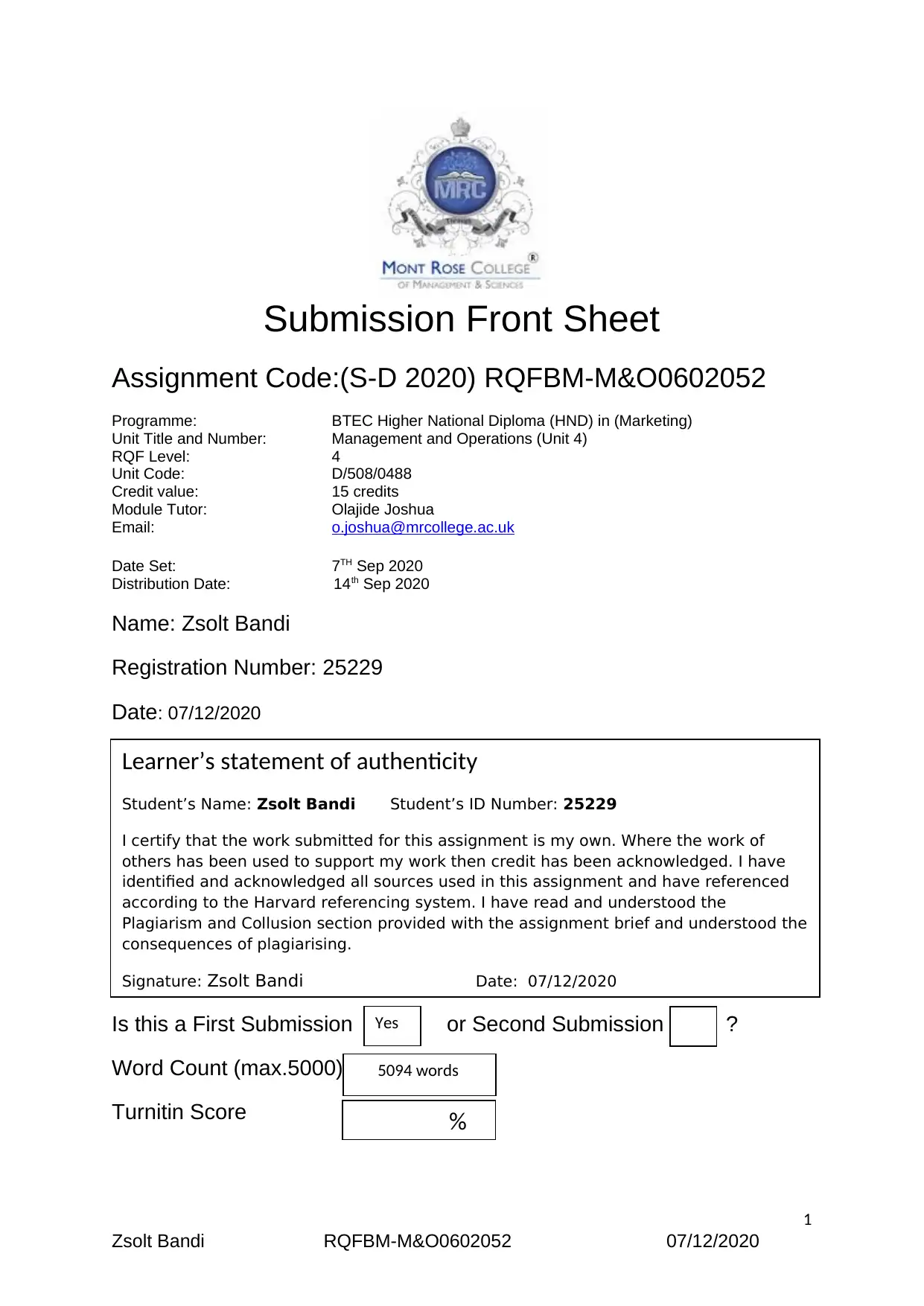
Submission Front Sheet
Assignment Code:(S-D 2020) RQFBM-M&O0602052
Programme: BTEC Higher National Diploma (HND) in (Marketing)
Unit Title and Number: Management and Operations (Unit 4)
RQF Level: 4
Unit Code: D/508/0488
Credit value: 15 credits
Module Tutor: Olajide Joshua
Email: o.joshua@mrcollege.ac.uk
Date Set: 7TH Sep 2020
Distribution Date: 14th Sep 2020
Name: Zsolt Bandi
Registration Number: 25229
Date: 07/12/2020
Is this a First Submission or Second Submission ?
Word Count (max.5000)
Turnitin Score
1
Zsolt Bandi RQFBM-M&O0602052 07/12/2020
Learner’s statement of authenticity
Student’s Name: Zsolt Bandi Student’s ID Number: 25229
I certify that the work submitted for this assignment is my own. Where the work of
others has been used to support my work then credit has been acknowledged. I have
identified and acknowledged all sources used in this assignment and have referenced
according to the Harvard referencing system. I have read and understood the
Plagiarism and Collusion section provided with the assignment brief and understood the
consequences of plagiarising.
Signature: Zsolt Bandi Date: 07/12/2020
Yes
5094 words
%
Assignment Code:(S-D 2020) RQFBM-M&O0602052
Programme: BTEC Higher National Diploma (HND) in (Marketing)
Unit Title and Number: Management and Operations (Unit 4)
RQF Level: 4
Unit Code: D/508/0488
Credit value: 15 credits
Module Tutor: Olajide Joshua
Email: o.joshua@mrcollege.ac.uk
Date Set: 7TH Sep 2020
Distribution Date: 14th Sep 2020
Name: Zsolt Bandi
Registration Number: 25229
Date: 07/12/2020
Is this a First Submission or Second Submission ?
Word Count (max.5000)
Turnitin Score
1
Zsolt Bandi RQFBM-M&O0602052 07/12/2020
Learner’s statement of authenticity
Student’s Name: Zsolt Bandi Student’s ID Number: 25229
I certify that the work submitted for this assignment is my own. Where the work of
others has been used to support my work then credit has been acknowledged. I have
identified and acknowledged all sources used in this assignment and have referenced
according to the Harvard referencing system. I have read and understood the
Plagiarism and Collusion section provided with the assignment brief and understood the
consequences of plagiarising.
Signature: Zsolt Bandi Date: 07/12/2020
Yes
5094 words
%
Paraphrase This Document
Need a fresh take? Get an instant paraphrase of this document with our AI Paraphraser
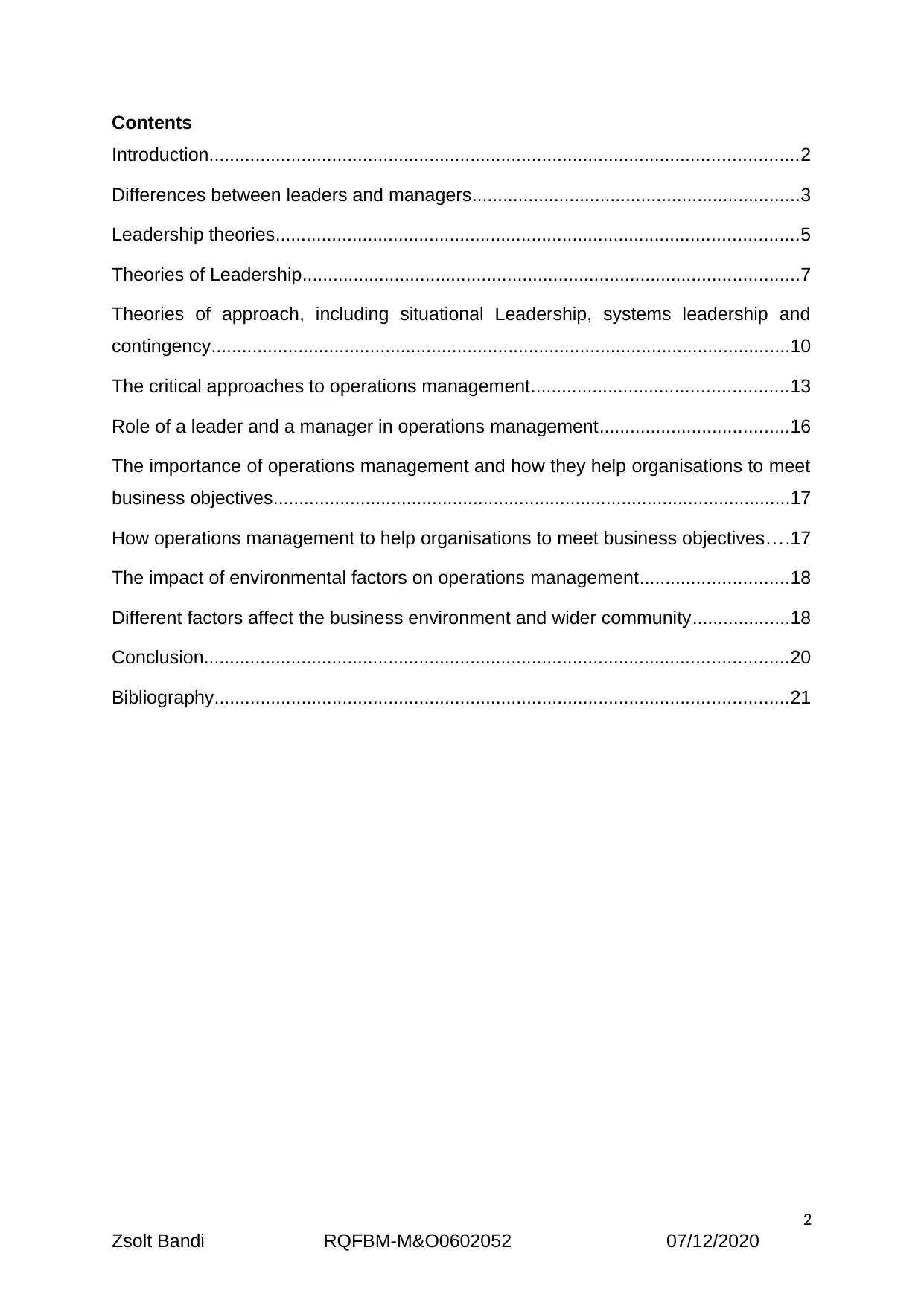
Contents
Introduction...................................................................................................................2
Differences between leaders and managers................................................................3
Leadership theories......................................................................................................5
Theories of Leadership.................................................................................................7
Theories of approach, including situational Leadership, systems leadership and
contingency.................................................................................................................10
The critical approaches to operations management..................................................13
Role of a leader and a manager in operations management.....................................16
The importance of operations management and how they help organisations to meet
business objectives.....................................................................................................17
How operations management to help organisations to meet business objectives....17
The impact of environmental factors on operations management.............................18
Different factors affect the business environment and wider community...................18
Conclusion..................................................................................................................20
Bibliography................................................................................................................21
2
Zsolt Bandi RQFBM-M&O0602052 07/12/2020
Introduction...................................................................................................................2
Differences between leaders and managers................................................................3
Leadership theories......................................................................................................5
Theories of Leadership.................................................................................................7
Theories of approach, including situational Leadership, systems leadership and
contingency.................................................................................................................10
The critical approaches to operations management..................................................13
Role of a leader and a manager in operations management.....................................16
The importance of operations management and how they help organisations to meet
business objectives.....................................................................................................17
How operations management to help organisations to meet business objectives....17
The impact of environmental factors on operations management.............................18
Different factors affect the business environment and wider community...................18
Conclusion..................................................................................................................20
Bibliography................................................................................................................21
2
Zsolt Bandi RQFBM-M&O0602052 07/12/2020
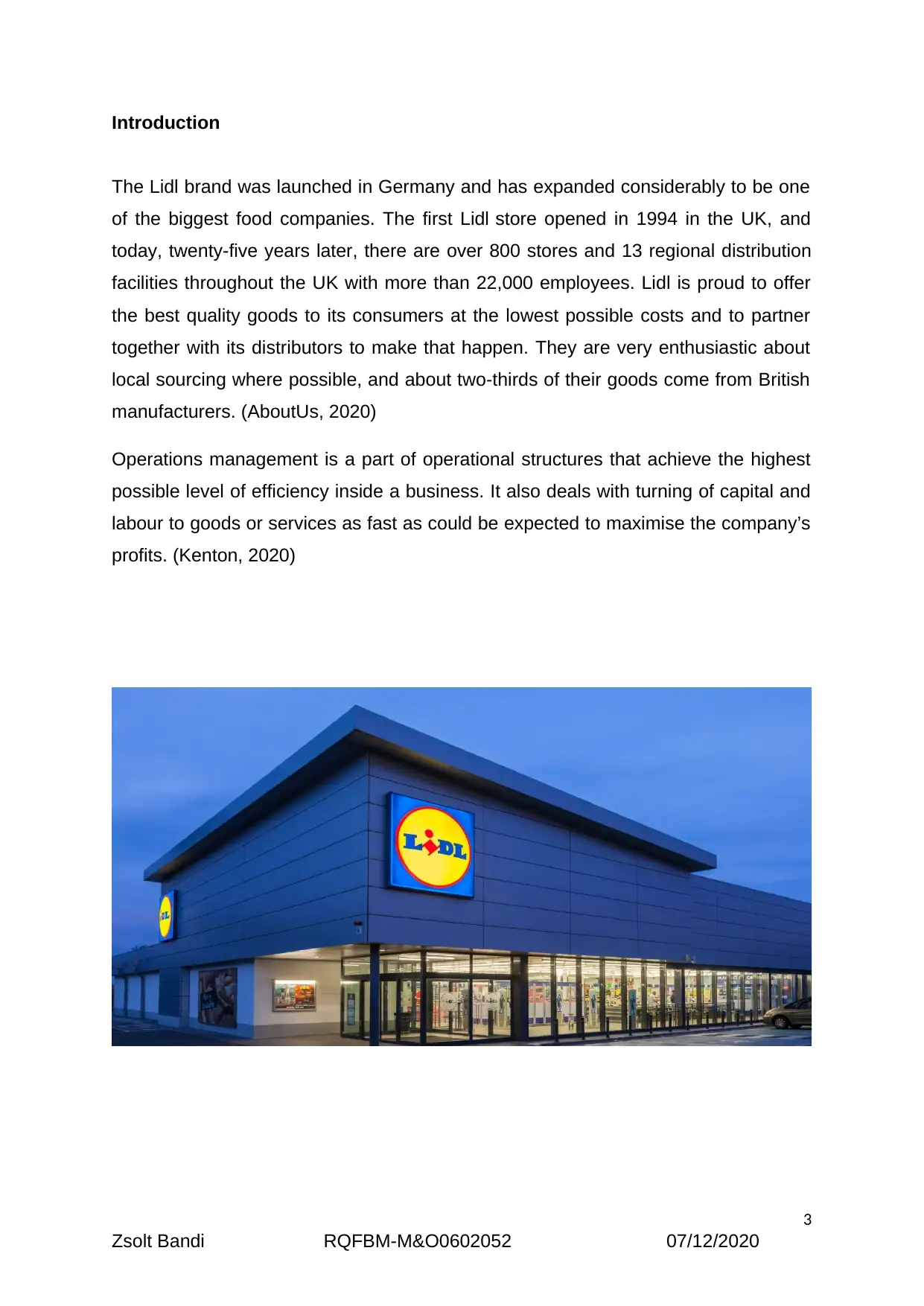
Introduction
The Lidl brand was launched in Germany and has expanded considerably to be one
of the biggest food companies. The first Lidl store opened in 1994 in the UK, and
today, twenty-five years later, there are over 800 stores and 13 regional distribution
facilities throughout the UK with more than 22,000 employees. Lidl is proud to offer
the best quality goods to its consumers at the lowest possible costs and to partner
together with its distributors to make that happen. They are very enthusiastic about
local sourcing where possible, and about two-thirds of their goods come from British
manufacturers. (AboutUs, 2020)
Operations management is a part of operational structures that achieve the highest
possible level of efficiency inside a business. It also deals with turning of capital and
labour to goods or services as fast as could be expected to maximise the company’s
profits. (Kenton, 2020)
3
Zsolt Bandi RQFBM-M&O0602052 07/12/2020
The Lidl brand was launched in Germany and has expanded considerably to be one
of the biggest food companies. The first Lidl store opened in 1994 in the UK, and
today, twenty-five years later, there are over 800 stores and 13 regional distribution
facilities throughout the UK with more than 22,000 employees. Lidl is proud to offer
the best quality goods to its consumers at the lowest possible costs and to partner
together with its distributors to make that happen. They are very enthusiastic about
local sourcing where possible, and about two-thirds of their goods come from British
manufacturers. (AboutUs, 2020)
Operations management is a part of operational structures that achieve the highest
possible level of efficiency inside a business. It also deals with turning of capital and
labour to goods or services as fast as could be expected to maximise the company’s
profits. (Kenton, 2020)
3
Zsolt Bandi RQFBM-M&O0602052 07/12/2020
⊘ This is a preview!⊘
Do you want full access?
Subscribe today to unlock all pages.

Trusted by 1+ million students worldwide
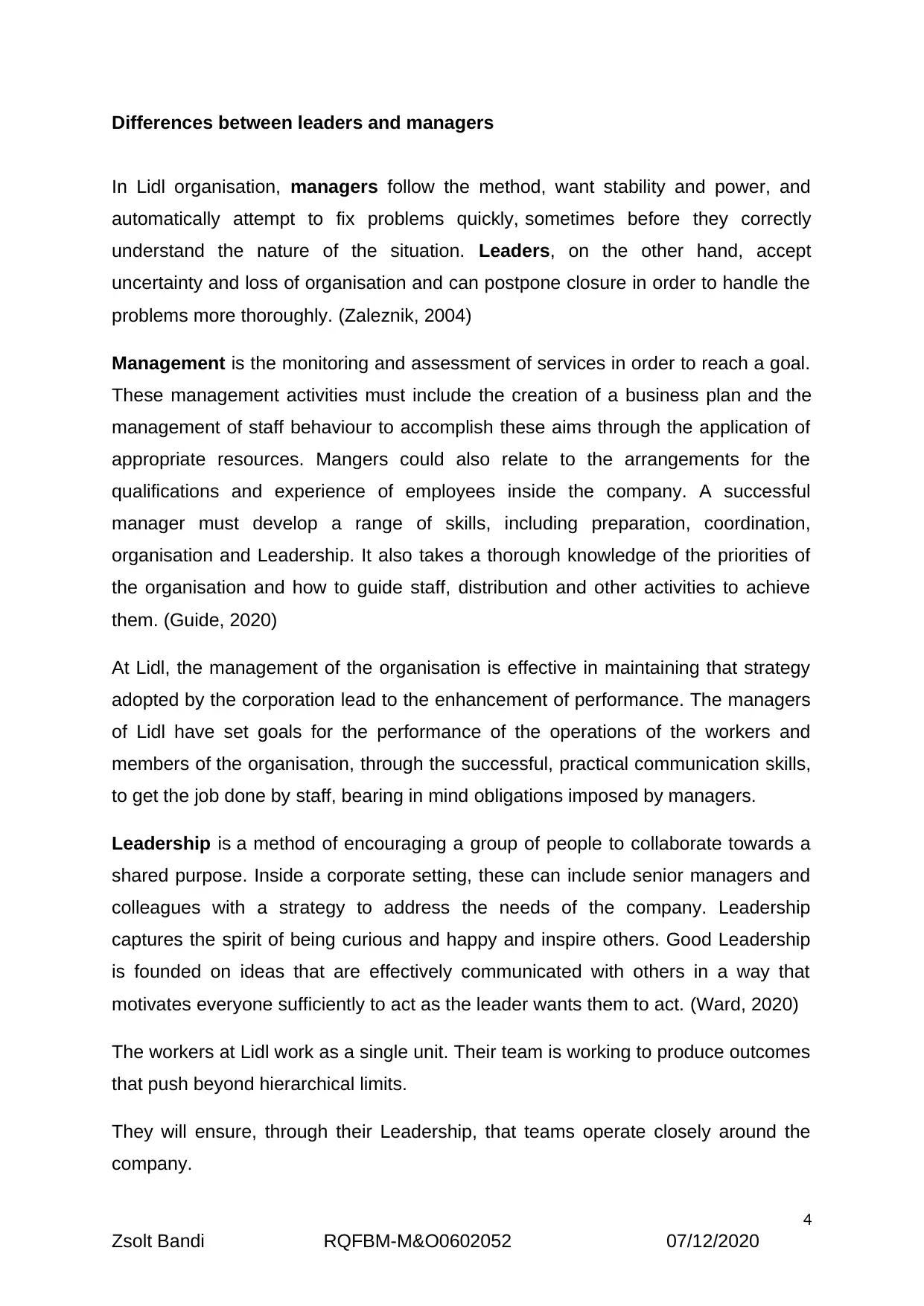
Differences between leaders and managers
In Lidl organisation, managers follow the method, want stability and power, and
automatically attempt to fix problems quickly, sometimes before they correctly
understand the nature of the situation. Leaders, on the other hand, accept
uncertainty and loss of organisation and can postpone closure in order to handle the
problems more thoroughly. (Zaleznik, 2004)
Management is the monitoring and assessment of services in order to reach a goal.
These management activities must include the creation of a business plan and the
management of staff behaviour to accomplish these aims through the application of
appropriate resources. Mangers could also relate to the arrangements for the
qualifications and experience of employees inside the company. A successful
manager must develop a range of skills, including preparation, coordination,
organisation and Leadership. It also takes a thorough knowledge of the priorities of
the organisation and how to guide staff, distribution and other activities to achieve
them. (Guide, 2020)
At Lidl, the management of the organisation is effective in maintaining that strategy
adopted by the corporation lead to the enhancement of performance. The managers
of Lidl have set goals for the performance of the operations of the workers and
members of the organisation, through the successful, practical communication skills,
to get the job done by staff, bearing in mind obligations imposed by managers.
Leadership is a method of encouraging a group of people to collaborate towards a
shared purpose. Inside a corporate setting, these can include senior managers and
colleagues with a strategy to address the needs of the company. Leadership
captures the spirit of being curious and happy and inspire others. Good Leadership
is founded on ideas that are effectively communicated with others in a way that
motivates everyone sufficiently to act as the leader wants them to act. (Ward, 2020)
The workers at Lidl work as a single unit. Their team is working to produce outcomes
that push beyond hierarchical limits.
They will ensure, through their Leadership, that teams operate closely around the
company.
4
Zsolt Bandi RQFBM-M&O0602052 07/12/2020
In Lidl organisation, managers follow the method, want stability and power, and
automatically attempt to fix problems quickly, sometimes before they correctly
understand the nature of the situation. Leaders, on the other hand, accept
uncertainty and loss of organisation and can postpone closure in order to handle the
problems more thoroughly. (Zaleznik, 2004)
Management is the monitoring and assessment of services in order to reach a goal.
These management activities must include the creation of a business plan and the
management of staff behaviour to accomplish these aims through the application of
appropriate resources. Mangers could also relate to the arrangements for the
qualifications and experience of employees inside the company. A successful
manager must develop a range of skills, including preparation, coordination,
organisation and Leadership. It also takes a thorough knowledge of the priorities of
the organisation and how to guide staff, distribution and other activities to achieve
them. (Guide, 2020)
At Lidl, the management of the organisation is effective in maintaining that strategy
adopted by the corporation lead to the enhancement of performance. The managers
of Lidl have set goals for the performance of the operations of the workers and
members of the organisation, through the successful, practical communication skills,
to get the job done by staff, bearing in mind obligations imposed by managers.
Leadership is a method of encouraging a group of people to collaborate towards a
shared purpose. Inside a corporate setting, these can include senior managers and
colleagues with a strategy to address the needs of the company. Leadership
captures the spirit of being curious and happy and inspire others. Good Leadership
is founded on ideas that are effectively communicated with others in a way that
motivates everyone sufficiently to act as the leader wants them to act. (Ward, 2020)
The workers at Lidl work as a single unit. Their team is working to produce outcomes
that push beyond hierarchical limits.
They will ensure, through their Leadership, that teams operate closely around the
company.
4
Zsolt Bandi RQFBM-M&O0602052 07/12/2020
Paraphrase This Document
Need a fresh take? Get an instant paraphrase of this document with our AI Paraphraser
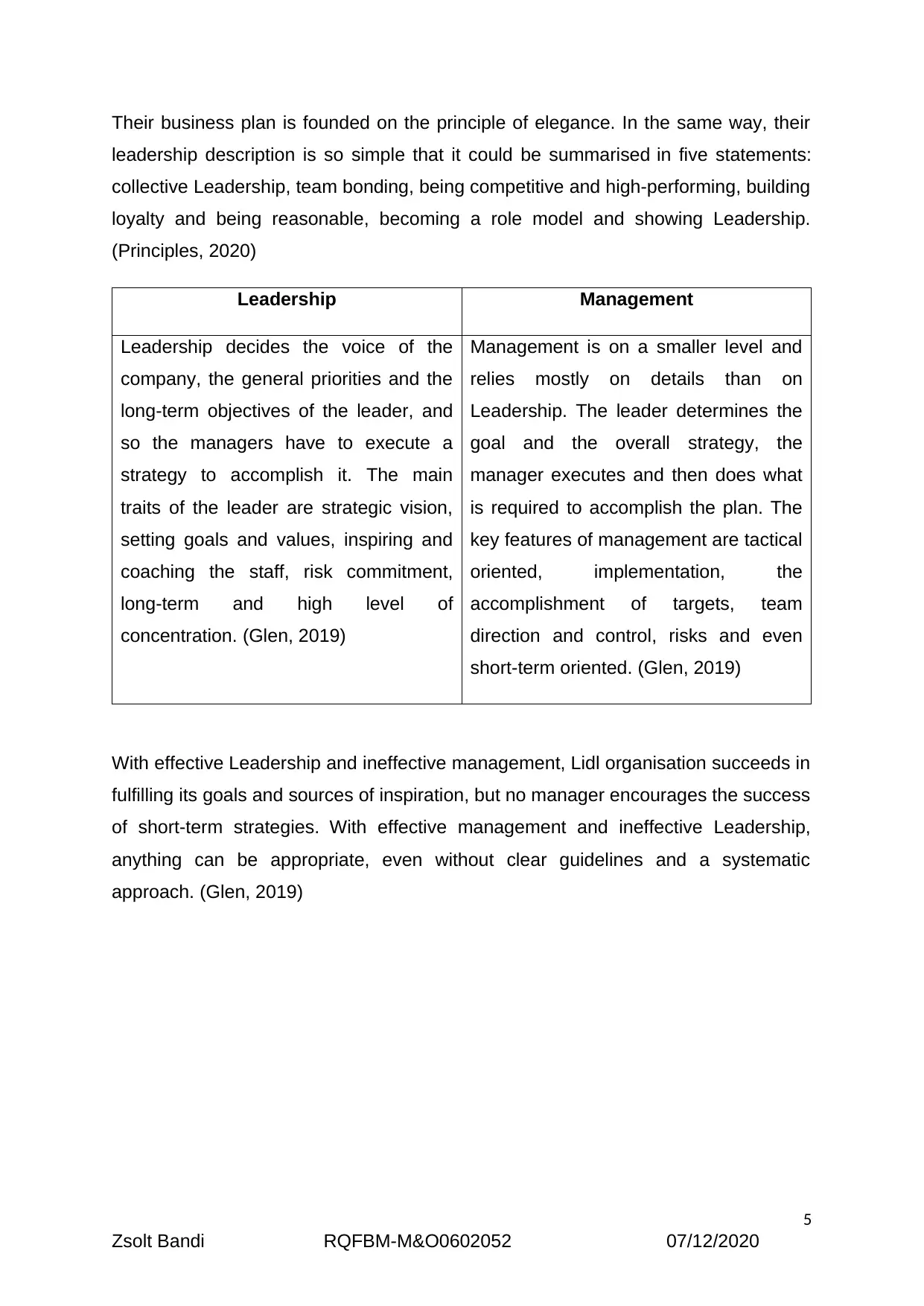
Their business plan is founded on the principle of elegance. In the same way, their
leadership description is so simple that it could be summarised in five statements:
collective Leadership, team bonding, being competitive and high-performing, building
loyalty and being reasonable, becoming a role model and showing Leadership.
(Principles, 2020)
Leadership Management
Leadership decides the voice of the
company, the general priorities and the
long-term objectives of the leader, and
so the managers have to execute a
strategy to accomplish it. The main
traits of the leader are strategic vision,
setting goals and values, inspiring and
coaching the staff, risk commitment,
long-term and high level of
concentration. (Glen, 2019)
Management is on a smaller level and
relies mostly on details than on
Leadership. The leader determines the
goal and the overall strategy, the
manager executes and then does what
is required to accomplish the plan. The
key features of management are tactical
oriented, implementation, the
accomplishment of targets, team
direction and control, risks and even
short-term oriented. (Glen, 2019)
With effective Leadership and ineffective management, Lidl organisation succeeds in
fulfilling its goals and sources of inspiration, but no manager encourages the success
of short-term strategies. With effective management and ineffective Leadership,
anything can be appropriate, even without clear guidelines and a systematic
approach. (Glen, 2019)
5
Zsolt Bandi RQFBM-M&O0602052 07/12/2020
leadership description is so simple that it could be summarised in five statements:
collective Leadership, team bonding, being competitive and high-performing, building
loyalty and being reasonable, becoming a role model and showing Leadership.
(Principles, 2020)
Leadership Management
Leadership decides the voice of the
company, the general priorities and the
long-term objectives of the leader, and
so the managers have to execute a
strategy to accomplish it. The main
traits of the leader are strategic vision,
setting goals and values, inspiring and
coaching the staff, risk commitment,
long-term and high level of
concentration. (Glen, 2019)
Management is on a smaller level and
relies mostly on details than on
Leadership. The leader determines the
goal and the overall strategy, the
manager executes and then does what
is required to accomplish the plan. The
key features of management are tactical
oriented, implementation, the
accomplishment of targets, team
direction and control, risks and even
short-term oriented. (Glen, 2019)
With effective Leadership and ineffective management, Lidl organisation succeeds in
fulfilling its goals and sources of inspiration, but no manager encourages the success
of short-term strategies. With effective management and ineffective Leadership,
anything can be appropriate, even without clear guidelines and a systematic
approach. (Glen, 2019)
5
Zsolt Bandi RQFBM-M&O0602052 07/12/2020
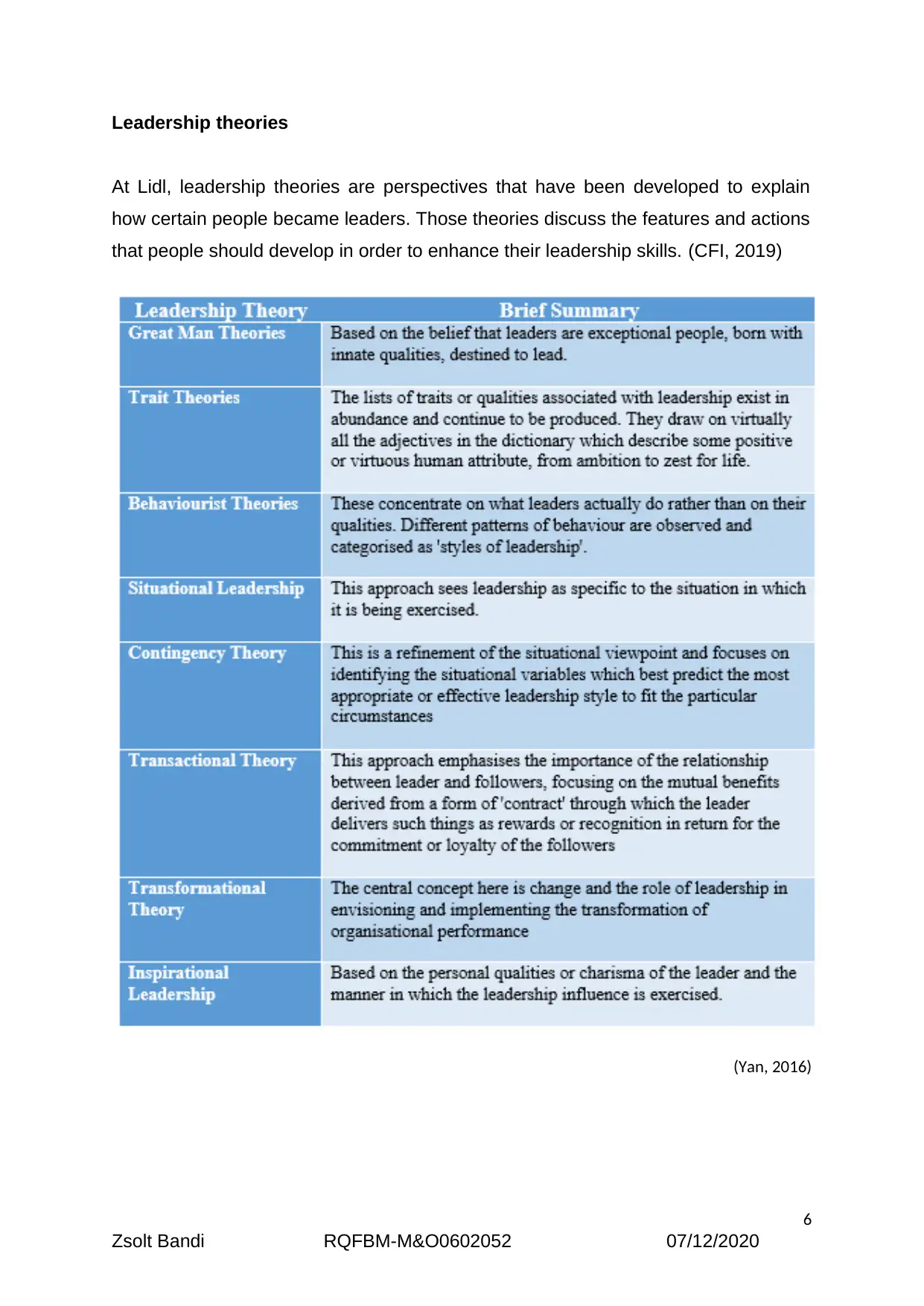
Leadership theories
At Lidl, leadership theories are perspectives that have been developed to explain
how certain people became leaders. Those theories discuss the features and actions
that people should develop in order to enhance their leadership skills. (CFI, 2019)
(Yan, 2016)
6
Zsolt Bandi RQFBM-M&O0602052 07/12/2020
At Lidl, leadership theories are perspectives that have been developed to explain
how certain people became leaders. Those theories discuss the features and actions
that people should develop in order to enhance their leadership skills. (CFI, 2019)
(Yan, 2016)
6
Zsolt Bandi RQFBM-M&O0602052 07/12/2020
⊘ This is a preview!⊘
Do you want full access?
Subscribe today to unlock all pages.

Trusted by 1+ million students worldwide
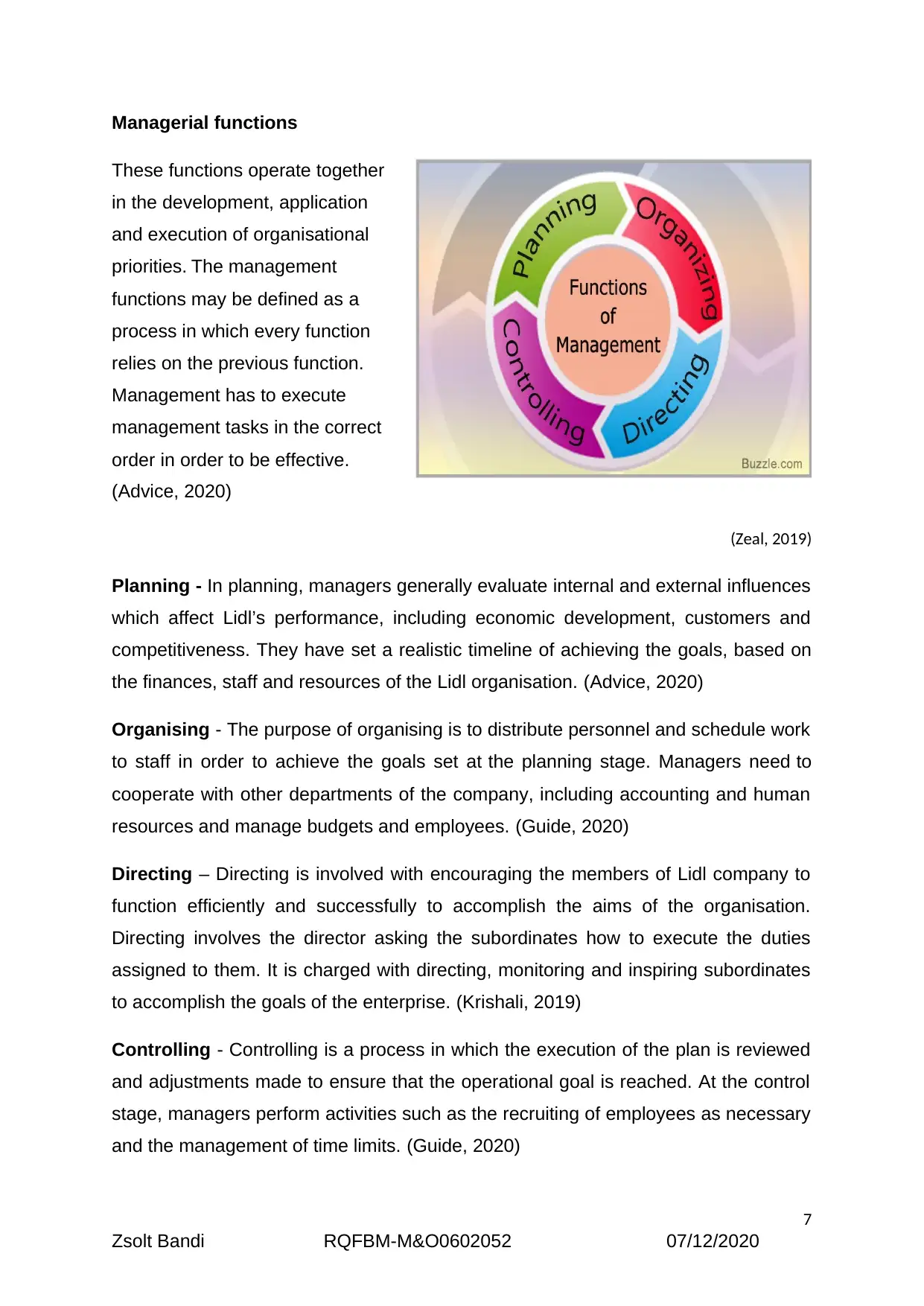
Managerial functions
These functions operate together
in the development, application
and execution of organisational
priorities. The management
functions may be defined as a
process in which every function
relies on the previous function.
Management has to execute
management tasks in the correct
order in order to be effective.
(Advice, 2020)
(Zeal, 2019)
Planning - In planning, managers generally evaluate internal and external influences
which affect Lidl’s performance, including economic development, customers and
competitiveness. They have set a realistic timeline of achieving the goals, based on
the finances, staff and resources of the Lidl organisation. (Advice, 2020)
Organising - The purpose of organising is to distribute personnel and schedule work
to staff in order to achieve the goals set at the planning stage. Managers need to
cooperate with other departments of the company, including accounting and human
resources and manage budgets and employees. (Guide, 2020)
Directing – Directing is involved with encouraging the members of Lidl company to
function efficiently and successfully to accomplish the aims of the organisation.
Directing involves the director asking the subordinates how to execute the duties
assigned to them. It is charged with directing, monitoring and inspiring subordinates
to accomplish the goals of the enterprise. (Krishali, 2019)
Controlling - Controlling is a process in which the execution of the plan is reviewed
and adjustments made to ensure that the operational goal is reached. At the control
stage, managers perform activities such as the recruiting of employees as necessary
and the management of time limits. (Guide, 2020)
7
Zsolt Bandi RQFBM-M&O0602052 07/12/2020
These functions operate together
in the development, application
and execution of organisational
priorities. The management
functions may be defined as a
process in which every function
relies on the previous function.
Management has to execute
management tasks in the correct
order in order to be effective.
(Advice, 2020)
(Zeal, 2019)
Planning - In planning, managers generally evaluate internal and external influences
which affect Lidl’s performance, including economic development, customers and
competitiveness. They have set a realistic timeline of achieving the goals, based on
the finances, staff and resources of the Lidl organisation. (Advice, 2020)
Organising - The purpose of organising is to distribute personnel and schedule work
to staff in order to achieve the goals set at the planning stage. Managers need to
cooperate with other departments of the company, including accounting and human
resources and manage budgets and employees. (Guide, 2020)
Directing – Directing is involved with encouraging the members of Lidl company to
function efficiently and successfully to accomplish the aims of the organisation.
Directing involves the director asking the subordinates how to execute the duties
assigned to them. It is charged with directing, monitoring and inspiring subordinates
to accomplish the goals of the enterprise. (Krishali, 2019)
Controlling - Controlling is a process in which the execution of the plan is reviewed
and adjustments made to ensure that the operational goal is reached. At the control
stage, managers perform activities such as the recruiting of employees as necessary
and the management of time limits. (Guide, 2020)
7
Zsolt Bandi RQFBM-M&O0602052 07/12/2020
Paraphrase This Document
Need a fresh take? Get an instant paraphrase of this document with our AI Paraphraser
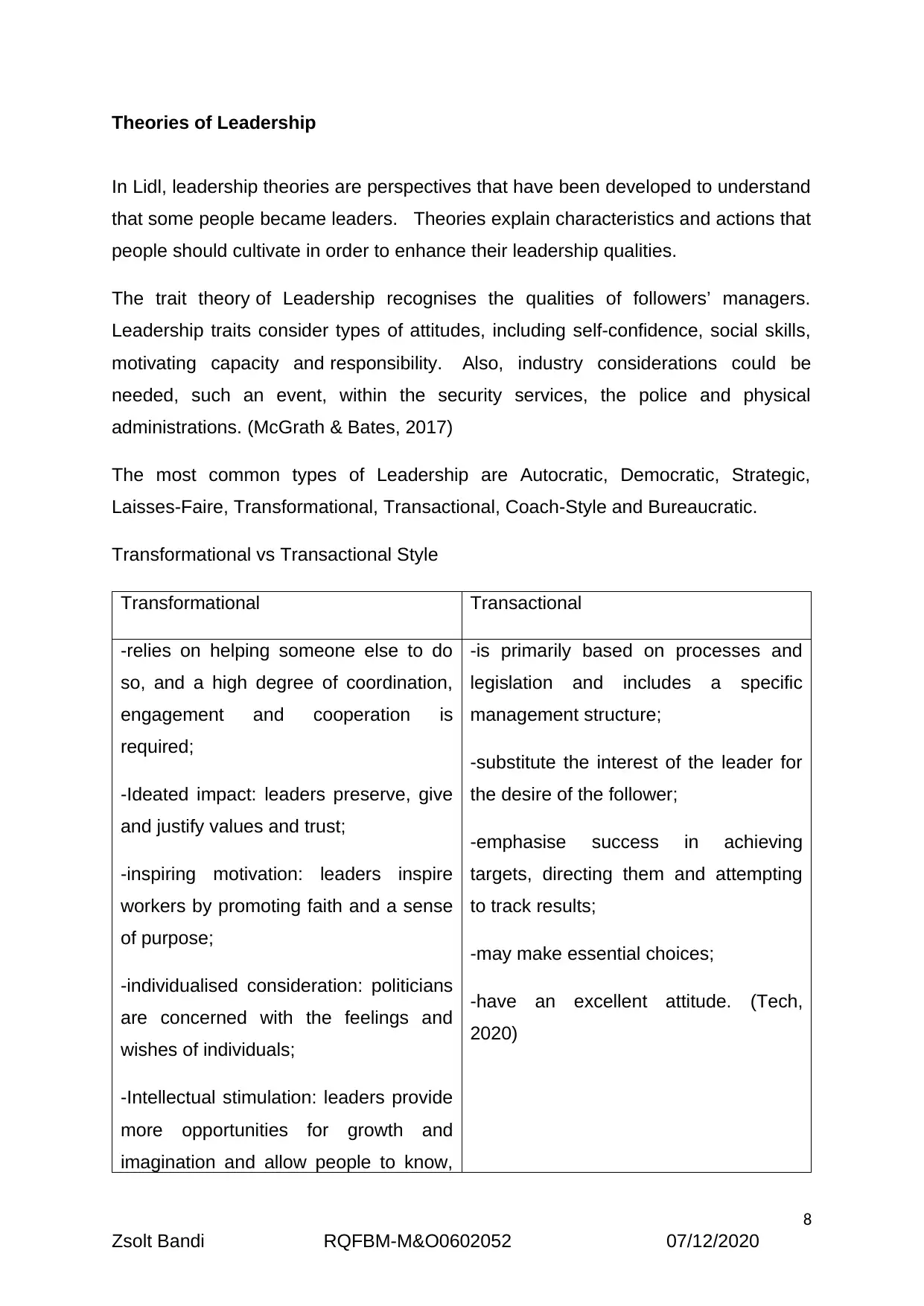
Theories of Leadership
In Lidl, leadership theories are perspectives that have been developed to understand
that some people became leaders. Theories explain characteristics and actions that
people should cultivate in order to enhance their leadership qualities.
The trait theory of Leadership recognises the qualities of followers’ managers.
Leadership traits consider types of attitudes, including self-confidence, social skills,
motivating capacity and responsibility. Also, industry considerations could be
needed, such an event, within the security services, the police and physical
administrations. (McGrath & Bates, 2017)
The most common types of Leadership are Autocratic, Democratic, Strategic,
Laisses-Faire, Transformational, Transactional, Coach-Style and Bureaucratic.
Transformational vs Transactional Style
Transformational Transactional
-relies on helping someone else to do
so, and a high degree of coordination,
engagement and cooperation is
required;
-Ideated impact: leaders preserve, give
and justify values and trust;
-inspiring motivation: leaders inspire
workers by promoting faith and a sense
of purpose;
-individualised consideration: politicians
are concerned with the feelings and
wishes of individuals;
-Intellectual stimulation: leaders provide
more opportunities for growth and
imagination and allow people to know,
-is primarily based on processes and
legislation and includes a specific
management structure;
-substitute the interest of the leader for
the desire of the follower;
-emphasise success in achieving
targets, directing them and attempting
to track results;
-may make essential choices;
-have an excellent attitude. (Tech,
2020)
8
Zsolt Bandi RQFBM-M&O0602052 07/12/2020
In Lidl, leadership theories are perspectives that have been developed to understand
that some people became leaders. Theories explain characteristics and actions that
people should cultivate in order to enhance their leadership qualities.
The trait theory of Leadership recognises the qualities of followers’ managers.
Leadership traits consider types of attitudes, including self-confidence, social skills,
motivating capacity and responsibility. Also, industry considerations could be
needed, such an event, within the security services, the police and physical
administrations. (McGrath & Bates, 2017)
The most common types of Leadership are Autocratic, Democratic, Strategic,
Laisses-Faire, Transformational, Transactional, Coach-Style and Bureaucratic.
Transformational vs Transactional Style
Transformational Transactional
-relies on helping someone else to do
so, and a high degree of coordination,
engagement and cooperation is
required;
-Ideated impact: leaders preserve, give
and justify values and trust;
-inspiring motivation: leaders inspire
workers by promoting faith and a sense
of purpose;
-individualised consideration: politicians
are concerned with the feelings and
wishes of individuals;
-Intellectual stimulation: leaders provide
more opportunities for growth and
imagination and allow people to know,
-is primarily based on processes and
legislation and includes a specific
management structure;
-substitute the interest of the leader for
the desire of the follower;
-emphasise success in achieving
targets, directing them and attempting
to track results;
-may make essential choices;
-have an excellent attitude. (Tech,
2020)
8
Zsolt Bandi RQFBM-M&O0602052 07/12/2020
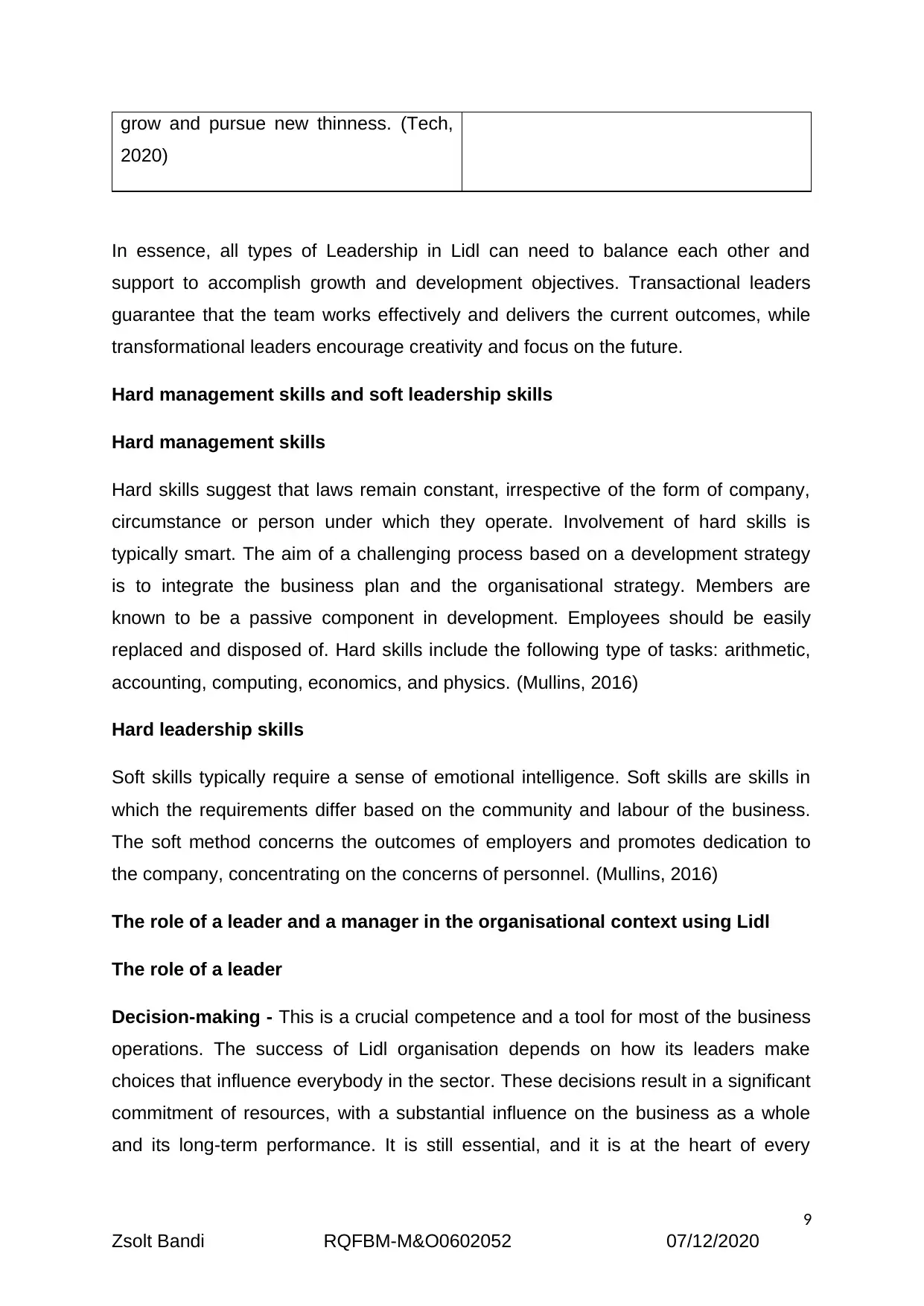
grow and pursue new thinness. (Tech,
2020)
In essence, all types of Leadership in Lidl can need to balance each other and
support to accomplish growth and development objectives. Transactional leaders
guarantee that the team works effectively and delivers the current outcomes, while
transformational leaders encourage creativity and focus on the future.
Hard management skills and soft leadership skills
Hard management skills
Hard skills suggest that laws remain constant, irrespective of the form of company,
circumstance or person under which they operate. Involvement of hard skills is
typically smart. The aim of a challenging process based on a development strategy
is to integrate the business plan and the organisational strategy. Members are
known to be a passive component in development. Employees should be easily
replaced and disposed of. Hard skills include the following type of tasks: arithmetic,
accounting, computing, economics, and physics. (Mullins, 2016)
Hard leadership skills
Soft skills typically require a sense of emotional intelligence. Soft skills are skills in
which the requirements differ based on the community and labour of the business.
The soft method concerns the outcomes of employers and promotes dedication to
the company, concentrating on the concerns of personnel. (Mullins, 2016)
The role of a leader and a manager in the organisational context using Lidl
The role of a leader
Decision-making - This is a crucial competence and a tool for most of the business
operations. The success of Lidl organisation depends on how its leaders make
choices that influence everybody in the sector. These decisions result in a significant
commitment of resources, with a substantial influence on the business as a whole
and its long-term performance. It is still essential, and it is at the heart of every
9
Zsolt Bandi RQFBM-M&O0602052 07/12/2020
2020)
In essence, all types of Leadership in Lidl can need to balance each other and
support to accomplish growth and development objectives. Transactional leaders
guarantee that the team works effectively and delivers the current outcomes, while
transformational leaders encourage creativity and focus on the future.
Hard management skills and soft leadership skills
Hard management skills
Hard skills suggest that laws remain constant, irrespective of the form of company,
circumstance or person under which they operate. Involvement of hard skills is
typically smart. The aim of a challenging process based on a development strategy
is to integrate the business plan and the organisational strategy. Members are
known to be a passive component in development. Employees should be easily
replaced and disposed of. Hard skills include the following type of tasks: arithmetic,
accounting, computing, economics, and physics. (Mullins, 2016)
Hard leadership skills
Soft skills typically require a sense of emotional intelligence. Soft skills are skills in
which the requirements differ based on the community and labour of the business.
The soft method concerns the outcomes of employers and promotes dedication to
the company, concentrating on the concerns of personnel. (Mullins, 2016)
The role of a leader and a manager in the organisational context using Lidl
The role of a leader
Decision-making - This is a crucial competence and a tool for most of the business
operations. The success of Lidl organisation depends on how its leaders make
choices that influence everybody in the sector. These decisions result in a significant
commitment of resources, with a substantial influence on the business as a whole
and its long-term performance. It is still essential, and it is at the heart of every
9
Zsolt Bandi RQFBM-M&O0602052 07/12/2020
⊘ This is a preview!⊘
Do you want full access?
Subscribe today to unlock all pages.

Trusted by 1+ million students worldwide
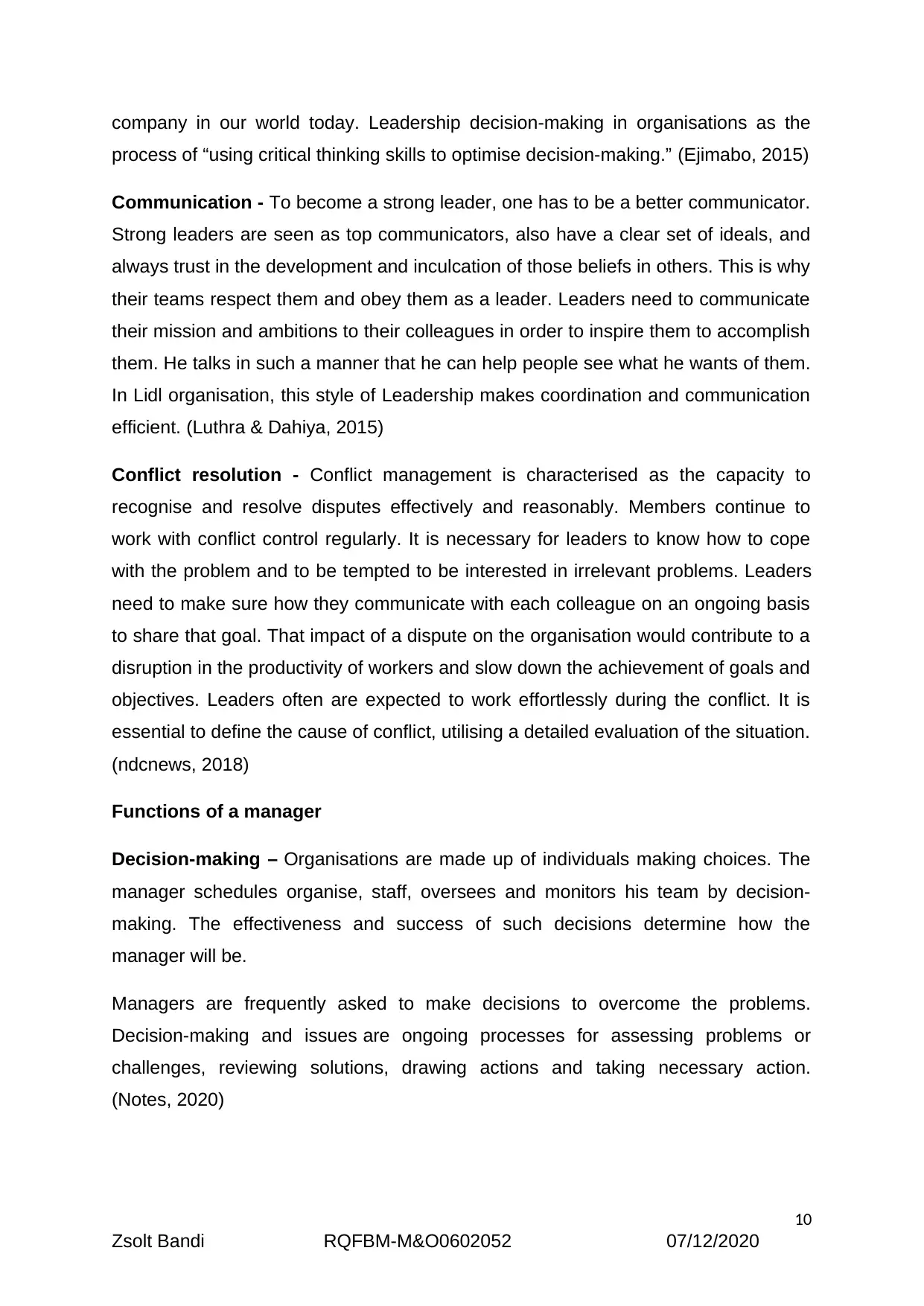
company in our world today. Leadership decision-making in organisations as the
process of “using critical thinking skills to optimise decision-making.” (Ejimabo, 2015)
Communication - To become a strong leader, one has to be a better communicator.
Strong leaders are seen as top communicators, also have a clear set of ideals, and
always trust in the development and inculcation of those beliefs in others. This is why
their teams respect them and obey them as a leader. Leaders need to communicate
their mission and ambitions to their colleagues in order to inspire them to accomplish
them. He talks in such a manner that he can help people see what he wants of them.
In Lidl organisation, this style of Leadership makes coordination and communication
efficient. (Luthra & Dahiya, 2015)
Conflict resolution - Conflict management is characterised as the capacity to
recognise and resolve disputes effectively and reasonably. Members continue to
work with conflict control regularly. It is necessary for leaders to know how to cope
with the problem and to be tempted to be interested in irrelevant problems. Leaders
need to make sure how they communicate with each colleague on an ongoing basis
to share that goal. That impact of a dispute on the organisation would contribute to a
disruption in the productivity of workers and slow down the achievement of goals and
objectives. Leaders often are expected to work effortlessly during the conflict. It is
essential to define the cause of conflict, utilising a detailed evaluation of the situation.
(ndcnews, 2018)
Functions of a manager
Decision-making – Organisations are made up of individuals making choices. The
manager schedules organise, staff, oversees and monitors his team by decision-
making. The effectiveness and success of such decisions determine how the
manager will be.
Managers are frequently asked to make decisions to overcome the problems.
Decision-making and issues are ongoing processes for assessing problems or
challenges, reviewing solutions, drawing actions and taking necessary action.
(Notes, 2020)
10
Zsolt Bandi RQFBM-M&O0602052 07/12/2020
process of “using critical thinking skills to optimise decision-making.” (Ejimabo, 2015)
Communication - To become a strong leader, one has to be a better communicator.
Strong leaders are seen as top communicators, also have a clear set of ideals, and
always trust in the development and inculcation of those beliefs in others. This is why
their teams respect them and obey them as a leader. Leaders need to communicate
their mission and ambitions to their colleagues in order to inspire them to accomplish
them. He talks in such a manner that he can help people see what he wants of them.
In Lidl organisation, this style of Leadership makes coordination and communication
efficient. (Luthra & Dahiya, 2015)
Conflict resolution - Conflict management is characterised as the capacity to
recognise and resolve disputes effectively and reasonably. Members continue to
work with conflict control regularly. It is necessary for leaders to know how to cope
with the problem and to be tempted to be interested in irrelevant problems. Leaders
need to make sure how they communicate with each colleague on an ongoing basis
to share that goal. That impact of a dispute on the organisation would contribute to a
disruption in the productivity of workers and slow down the achievement of goals and
objectives. Leaders often are expected to work effortlessly during the conflict. It is
essential to define the cause of conflict, utilising a detailed evaluation of the situation.
(ndcnews, 2018)
Functions of a manager
Decision-making – Organisations are made up of individuals making choices. The
manager schedules organise, staff, oversees and monitors his team by decision-
making. The effectiveness and success of such decisions determine how the
manager will be.
Managers are frequently asked to make decisions to overcome the problems.
Decision-making and issues are ongoing processes for assessing problems or
challenges, reviewing solutions, drawing actions and taking necessary action.
(Notes, 2020)
10
Zsolt Bandi RQFBM-M&O0602052 07/12/2020
Paraphrase This Document
Need a fresh take? Get an instant paraphrase of this document with our AI Paraphraser
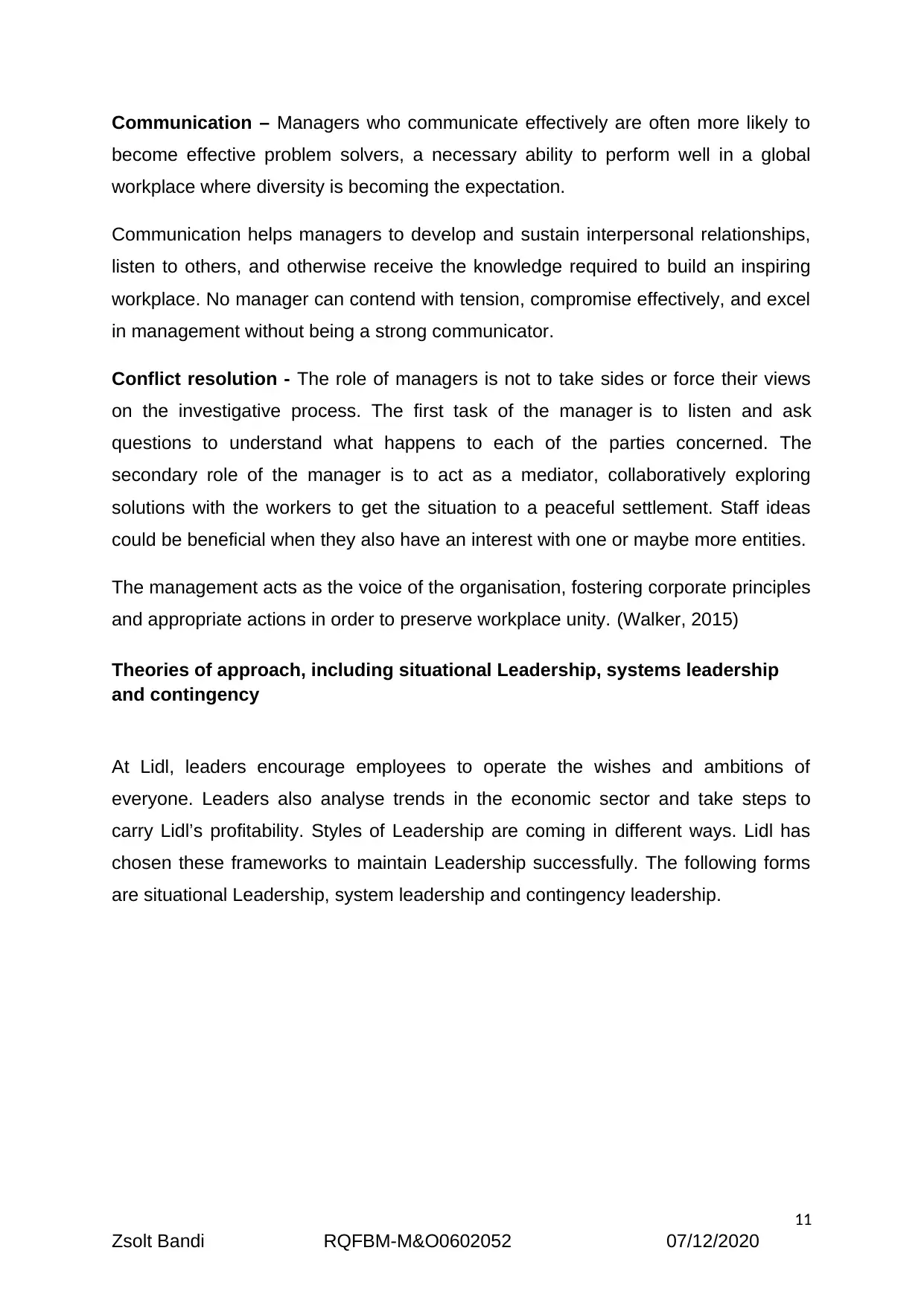
Communication – Managers who communicate effectively are often more likely to
become effective problem solvers, a necessary ability to perform well in a global
workplace where diversity is becoming the expectation.
Communication helps managers to develop and sustain interpersonal relationships,
listen to others, and otherwise receive the knowledge required to build an inspiring
workplace. No manager can contend with tension, compromise effectively, and excel
in management without being a strong communicator.
Conflict resolution - The role of managers is not to take sides or force their views
on the investigative process. The first task of the manager is to listen and ask
questions to understand what happens to each of the parties concerned. The
secondary role of the manager is to act as a mediator, collaboratively exploring
solutions with the workers to get the situation to a peaceful settlement. Staff ideas
could be beneficial when they also have an interest with one or maybe more entities.
The management acts as the voice of the organisation, fostering corporate principles
and appropriate actions in order to preserve workplace unity. (Walker, 2015)
Theories of approach, including situational Leadership, systems leadership
and contingency
At Lidl, leaders encourage employees to operate the wishes and ambitions of
everyone. Leaders also analyse trends in the economic sector and take steps to
carry Lidl’s profitability. Styles of Leadership are coming in different ways. Lidl has
chosen these frameworks to maintain Leadership successfully. The following forms
are situational Leadership, system leadership and contingency leadership.
11
Zsolt Bandi RQFBM-M&O0602052 07/12/2020
become effective problem solvers, a necessary ability to perform well in a global
workplace where diversity is becoming the expectation.
Communication helps managers to develop and sustain interpersonal relationships,
listen to others, and otherwise receive the knowledge required to build an inspiring
workplace. No manager can contend with tension, compromise effectively, and excel
in management without being a strong communicator.
Conflict resolution - The role of managers is not to take sides or force their views
on the investigative process. The first task of the manager is to listen and ask
questions to understand what happens to each of the parties concerned. The
secondary role of the manager is to act as a mediator, collaboratively exploring
solutions with the workers to get the situation to a peaceful settlement. Staff ideas
could be beneficial when they also have an interest with one or maybe more entities.
The management acts as the voice of the organisation, fostering corporate principles
and appropriate actions in order to preserve workplace unity. (Walker, 2015)
Theories of approach, including situational Leadership, systems leadership
and contingency
At Lidl, leaders encourage employees to operate the wishes and ambitions of
everyone. Leaders also analyse trends in the economic sector and take steps to
carry Lidl’s profitability. Styles of Leadership are coming in different ways. Lidl has
chosen these frameworks to maintain Leadership successfully. The following forms
are situational Leadership, system leadership and contingency leadership.
11
Zsolt Bandi RQFBM-M&O0602052 07/12/2020
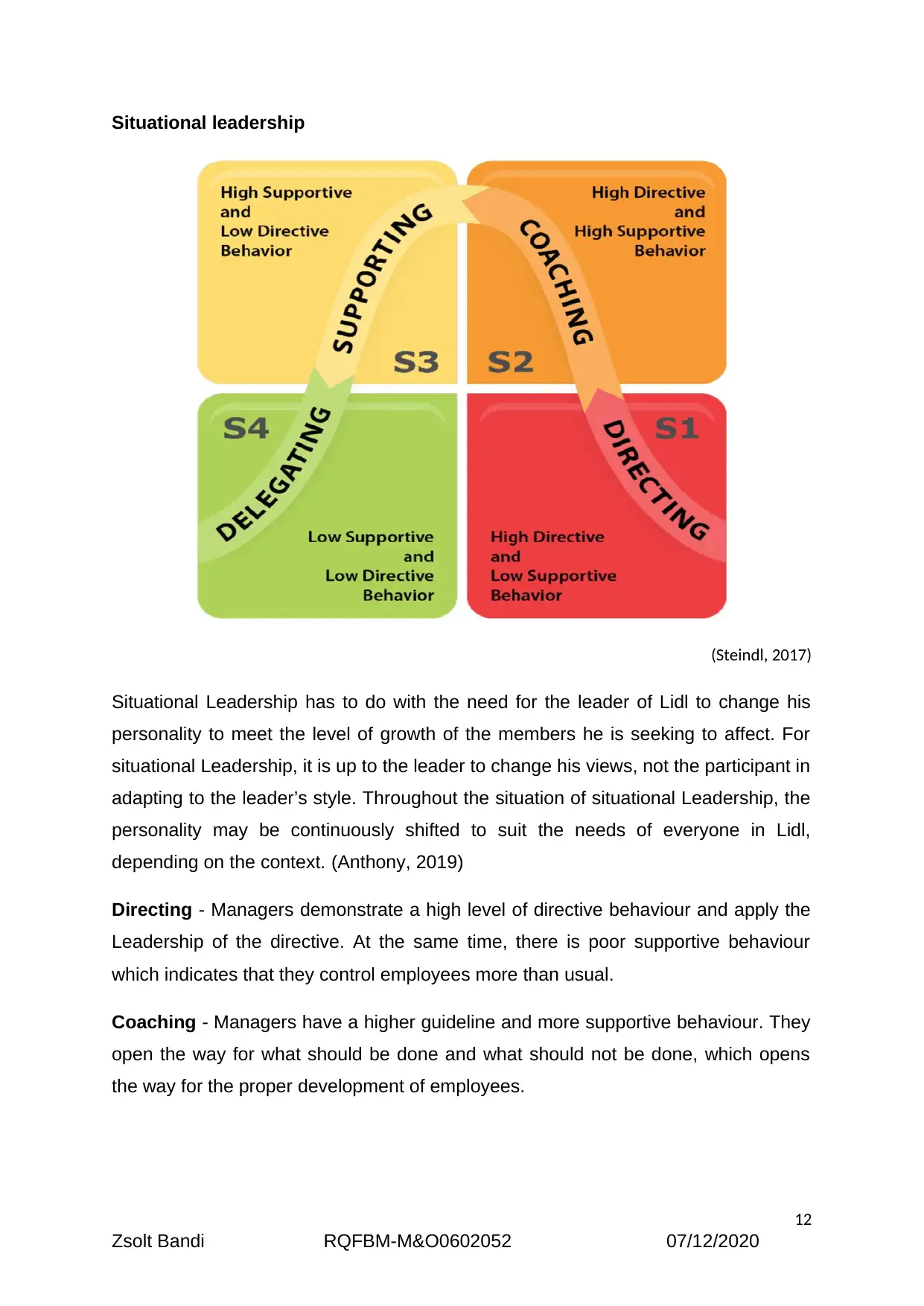
Situational leadership
(Steindl, 2017)
Situational Leadership has to do with the need for the leader of Lidl to change his
personality to meet the level of growth of the members he is seeking to affect. For
situational Leadership, it is up to the leader to change his views, not the participant in
adapting to the leader’s style. Throughout the situation of situational Leadership, the
personality may be continuously shifted to suit the needs of everyone in Lidl,
depending on the context. (Anthony, 2019)
Directing - Managers demonstrate a high level of directive behaviour and apply the
Leadership of the directive. At the same time, there is poor supportive behaviour
which indicates that they control employees more than usual.
Coaching - Managers have a higher guideline and more supportive behaviour. They
open the way for what should be done and what should not be done, which opens
the way for the proper development of employees.
12
Zsolt Bandi RQFBM-M&O0602052 07/12/2020
(Steindl, 2017)
Situational Leadership has to do with the need for the leader of Lidl to change his
personality to meet the level of growth of the members he is seeking to affect. For
situational Leadership, it is up to the leader to change his views, not the participant in
adapting to the leader’s style. Throughout the situation of situational Leadership, the
personality may be continuously shifted to suit the needs of everyone in Lidl,
depending on the context. (Anthony, 2019)
Directing - Managers demonstrate a high level of directive behaviour and apply the
Leadership of the directive. At the same time, there is poor supportive behaviour
which indicates that they control employees more than usual.
Coaching - Managers have a higher guideline and more supportive behaviour. They
open the way for what should be done and what should not be done, which opens
the way for the proper development of employees.
12
Zsolt Bandi RQFBM-M&O0602052 07/12/2020
⊘ This is a preview!⊘
Do you want full access?
Subscribe today to unlock all pages.

Trusted by 1+ million students worldwide
1 out of 26
Related Documents
Your All-in-One AI-Powered Toolkit for Academic Success.
+13062052269
info@desklib.com
Available 24*7 on WhatsApp / Email
![[object Object]](/_next/static/media/star-bottom.7253800d.svg)
Unlock your academic potential
Copyright © 2020–2025 A2Z Services. All Rights Reserved. Developed and managed by ZUCOL.





